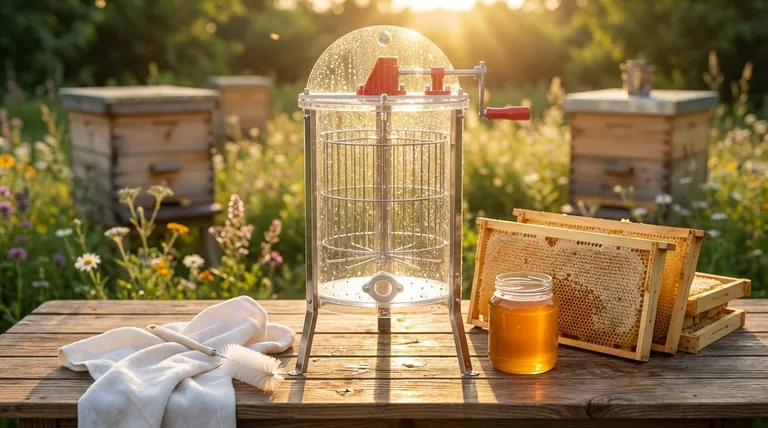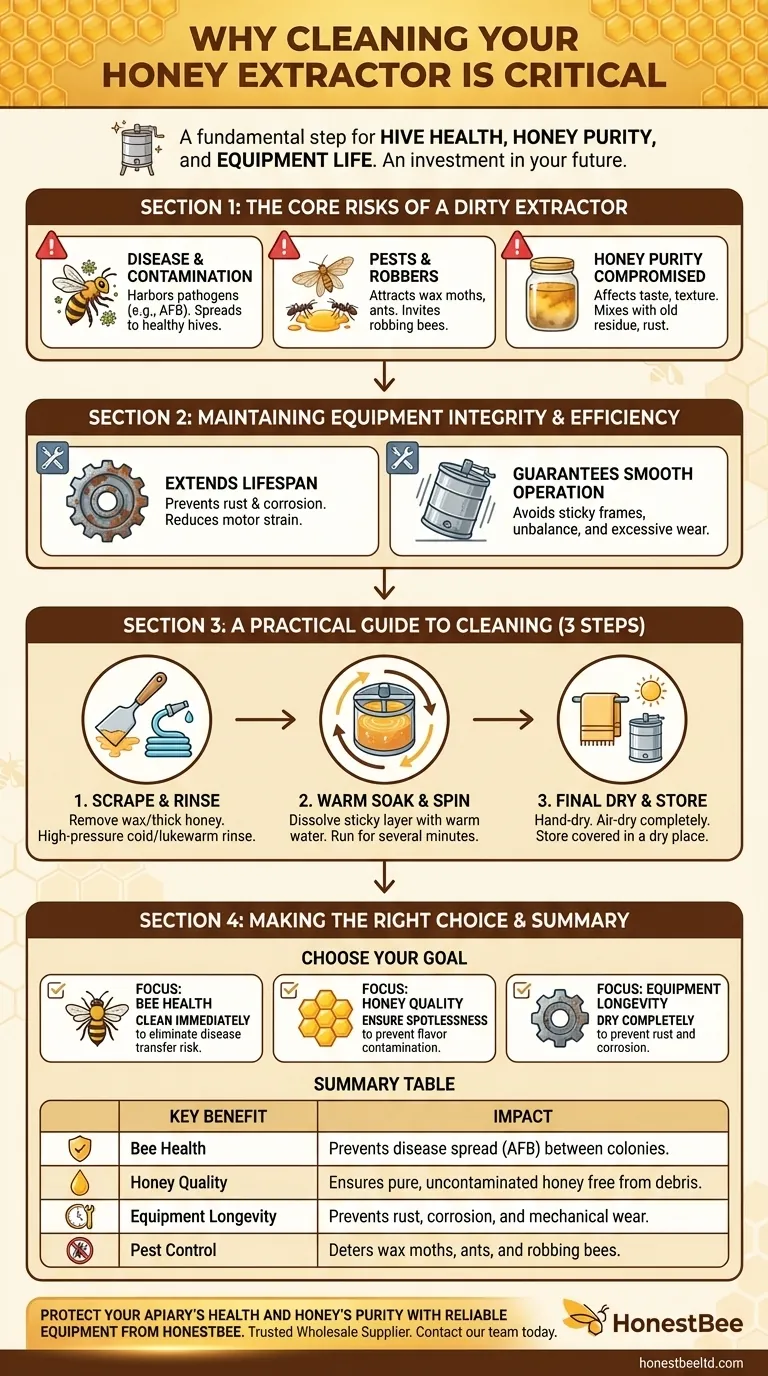To put it simply, keeping your honey extractor clean is a critical step in responsible beekeeping that directly protects the health of your bees, the quality of your honey, and the longevity of your equipment. Failing to clean it properly introduces significant risks, turning a valuable tool into a potential vector for disease and contamination.
A clean honey extractor is not just about maintenance; it is a fundamental control point for ensuring hive health and producing pure, high-quality honey. It is an investment in the future of both your bees and your harvest.

The Core Risks of a Dirty Extractor
Leaving honey, wax, and propolis residue in an extractor after use creates a cascade of potential problems. Understanding these risks highlights why immediate and thorough cleaning is non-negotiable.
Preventing Contamination and Disease
Honey residue left in an extractor can harbor pathogens. If these contaminants are from a hive with a disease like American Foulbrood (AFB), the spores can easily be transferred to the honey from healthy hives during the next extraction, spreading the infection throughout your apiary.
Deterring Pests and Robbers
The sweet smell of leftover honey is an open invitation to pests. Wax moths, ants, and other insects can infest and damage your equipment. It can also attract robbing bees from other colonies, which can create a frenzy and potentially spread mites and diseases back to your hives.
Ensuring Honey Purity and Quality
A dirty extractor compromises the product you worked so hard to produce. Old, crystallized honey, flecks of rust, or debris from previous extractions can mix with your fresh harvest, affecting its taste, texture, and purity.
Maintaining Equipment Integrity and Efficiency
Beyond hygiene, cleanliness is a matter of practical maintenance. A well-maintained extractor is a reliable tool that will serve you for years.
Extending the Extractor's Lifespan
Hardened honey and wax residue can put a significant strain on the extractor's motor and moving parts. More importantly, any moisture left in an uncleaned extractor will inevitably lead to rust and corrosion, especially on stainless steel components, permanently damaging the equipment.
Guaranteeing Smooth Operation
Sticky residue makes the entire extraction process more difficult. It can cause frames to stick, unbalance the drum during spinning, and lead to excessive vibration that can cause premature wear and tear on bearings and gears.
A Practical Guide to Cleaning Your Extractor
The cleaning process is straightforward but must be done thoroughly. The goal is to remove all organic matter and ensure the equipment is completely dry before storage.
The Initial Scrape and Rinse
First, use a soft plastic spatula to scrape out as much wax and thick honey as possible. Following the scrape, a high-pressure rinse with cold or lukewarm water will remove the bulk of the remaining residue.
The Warm Water Soak
Next, use warm water and a soft cloth or brush to dissolve the final layer of sticky honey. You can pour a few gallons of warm water into the extractor, close the lid, and run it for several minutes. This uses centrifugal force to clean the basket and drum walls effectively.
Final Drying and Storage
This is the most critical step for preventing rust. After draining all water, hand-dry the interior and exterior with clean towels. To ensure it's completely dry, let it air-dry in a warm, sunny spot for several hours before storing it in a clean, dry location, preferably covered.
Making the Right Choice for Your Goal
Integrating extractor maintenance into your workflow is key to success. Your focus should determine your immediate priority.
- If your primary focus is bee health: Clean your extractor immediately after use to eliminate any risk of transferring diseases like foulbrood between your colonies.
- If your primary focus is honey quality: Ensure every component, from the extractor drum to the honey gate, is spotless to prevent any contaminants from marring the flavor and purity of your harvest.
- If your primary focus is equipment longevity: Always dry your extractor completely after washing to prevent rust and corrosion, protecting your financial investment for future seasons.
Ultimately, diligent cleaning is a cornerstone of beekeeping that pays dividends in hive health, product quality, and equipment reliability.
Summary Table:
| Key Benefit | Impact of a Clean Extractor |
|---|---|
| Bee Health | Prevents the spread of diseases like American Foulbrood between colonies. |
| Honey Quality | Ensures pure, uncontaminated honey free from debris and off-flavors. |
| Equipment Longevity | Prevents rust, corrosion, and mechanical wear for a longer-lasting extractor. |
| Pest Control | Deters wax moths, ants, and robbing bees attracted to honey residue. |
Protect your apiary's health and your honey's purity with reliable equipment from HONESTBEE. Proper maintenance starts with quality tools. As a trusted wholesale supplier for commercial apiaries and beekeeping equipment distributors, we provide the durable, easy-to-clean extractors and supplies you need for a successful harvest. Contact our team today to discuss your wholesale needs and ensure your operation is built on a foundation of excellence and hygiene.
Visual Guide

Related Products
- HONESTBEE 3-Frame Manual Acrylic Honey Extractor
- Electric 8 Frame Honey Spinner Extractor Equipment for Beekeeping
- electric honey extractor honey centrifuge 3 frame honey extractor stainless steel honey frame extractor
- HONESTBEE 72 Frame Industrial Electric Honey Extractor for Beekeeping
- 6 Frame Manual Stainless Steel Honey Extractor Beekeeping Equipment
People Also Ask
- What size honey extractor do I need? Match Frame Capacity to Your Hives for Maximum Efficiency
- What equipment is used for honey harvest? Essential Tools for Every Beekeeper
- How often do beekeepers collect honey? Maximize Your Hive's Sustainable Yield
- What is a fun and easy alternative to using a honey extractor for harvesting honey? Try the Crush and Strain Method
- How do you collect honey at home? A Beginner's Guide to Harvesting from Your Hive



















